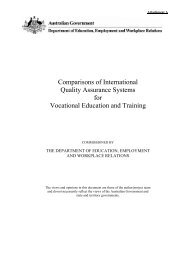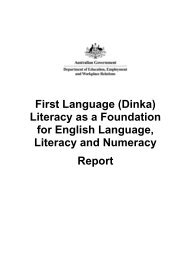Epidemics in a Changing World - Department of Innovation, Industry ...
Epidemics in a Changing World - Department of Innovation, Industry ...
Epidemics in a Changing World - Department of Innovation, Industry ...
You also want an ePaper? Increase the reach of your titles
YUMPU automatically turns print PDFs into web optimized ePapers that Google loves.
Appendix 2: Detailed Terms <strong>of</strong> Reference<br />
The PMSEIC Expert Work<strong>in</strong>g Group on the thematic issue <strong>of</strong> epidemics will address the issue<br />
both from a national and <strong>in</strong>ternational perspective. It will prepare a written report (a full<br />
technical report <strong>in</strong>clud<strong>in</strong>g a summary for policy makers) and a presentation for the PMSEIC 5<br />
June 2009 meet<strong>in</strong>g that presents a strategic viewpo<strong>in</strong>t by:<br />
EpidemICs <strong>in</strong> a Chang<strong>in</strong>g <strong>World</strong><br />
Report <strong>of</strong> the Expert Work<strong>in</strong>g Group<br />
26<br />
1. Identify<strong>in</strong>g key emerg<strong>in</strong>g risks and threats for spontaneous pathogen-mediated epidemics<br />
<strong>in</strong> Australia <strong>in</strong> the context <strong>of</strong> climate change over the next few decades. 1<br />
2. Identify<strong>in</strong>g and summaris<strong>in</strong>g <strong>in</strong>formation on current measures, strategies, and related<br />
technologies that could assist <strong>in</strong> anticipat<strong>in</strong>g and mitigat<strong>in</strong>g the risk and impact <strong>of</strong><br />
epidemics. 2<br />
3. Identify<strong>in</strong>g the key factors likely to improve uptake <strong>of</strong> pre-emptive measures, strategies,<br />
and technologies.<br />
4. Determ<strong>in</strong><strong>in</strong>g any gaps <strong>in</strong> and constra<strong>in</strong>ts to research and development <strong>in</strong> these areas,<br />
<strong>in</strong>clud<strong>in</strong>g those related to human capacity and to any <strong>in</strong>tellectual property ramifications<br />
across jurisdictions.<br />
5. Outl<strong>in</strong><strong>in</strong>g current research, on a cont<strong>in</strong>uum from basic to applied, to prevent challenges<br />
posed by epidemics and mitigate their impact.<br />
6. Identify<strong>in</strong>g developments <strong>in</strong> forecast<strong>in</strong>g, conta<strong>in</strong>ment and prevention <strong>of</strong> epidemics (e.g.<br />
likelihood <strong>of</strong> zoonosis and <strong>of</strong> the emergence <strong>of</strong> new and highly virulent and drug-resistant<br />
pathogens through mix<strong>in</strong>g <strong>of</strong> exist<strong>in</strong>g stra<strong>in</strong>s, and prevention through the potential use <strong>of</strong><br />
vacc<strong>in</strong>es).<br />
7. The Expert Work<strong>in</strong>g Group will report its f<strong>in</strong>d<strong>in</strong>gs to PMSEIC and make recommendations<br />
on ways forward for Australia to address challenges posed by epidemics.<br />
1 Disease focus will <strong>in</strong>clude, but need not be restricted to, human <strong>in</strong>fluenza, avian <strong>in</strong>fluenza, equ<strong>in</strong>e <strong>in</strong>fluenza and Hendra virus <strong>in</strong>fection, multidrug<br />
resistant tuberculosis and vector-borne diseases such as viral encephalitis, dengue fever and malaria, other relevant diseases, such as<br />
measles and polio, which may be endemic <strong>in</strong> areas that are sources <strong>of</strong> migrants to Australia.<br />
2 Consideration should be given to exist<strong>in</strong>g policy and regulatory regimes, surveillance and monitor<strong>in</strong>g <strong>in</strong>frastructure, coord<strong>in</strong>ation mechanisms<br />
across national and <strong>in</strong>ternational boundaries, Australian <strong>in</strong>vestment <strong>in</strong> capacity build<strong>in</strong>g <strong>in</strong> the Asia-Pacific region to assist <strong>in</strong> controll<strong>in</strong>g<br />
outbreaks and reduc<strong>in</strong>g risk <strong>of</strong> exposure to Australia, the l<strong>in</strong>k between food production practices and the risk <strong>of</strong> epidemics, quarant<strong>in</strong>e and<br />
border security, immunisation status and vacc<strong>in</strong>ation <strong>of</strong> target populations both <strong>in</strong> Australia and with<strong>in</strong> the Asia-Pacific region, and potential<br />
cost, availability and registration status <strong>of</strong> vacc<strong>in</strong>es and medications especially <strong>in</strong> the context <strong>of</strong> an <strong>in</strong>ternational crisis, and centralis<strong>in</strong>g <strong>of</strong><br />
manufacture, stockpil<strong>in</strong>g and distribution <strong>of</strong> relevant treatments and medications.
















